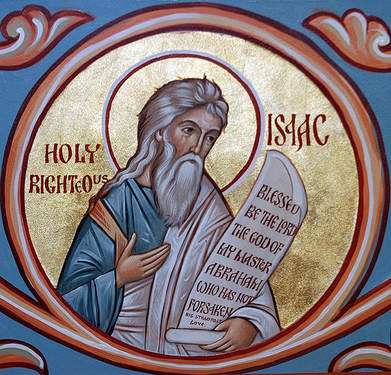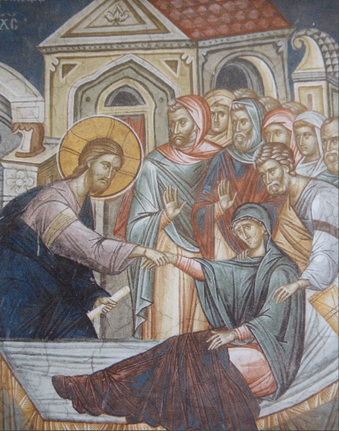 Homily preached by Father Richard Peers SMMS at All Saints'. “It was the best of times, it was the worst of times, it was the age of wisdom, it was the age of foolishness, it was the epoch of belief, it was the epoch of incredulity, it was the season of Light, it was the season of Darkness, it was the spring of hope, it was the winter of despair, we had everything before us, we had nothing before us …” It is, supposedly, the most famous opening to any book in the English language. Well, I have spent most of life as a teacher so I will ask you a question: can anyone name the book? Yes, of course, Dickens’ ‘A Tale of Two Cities’. “The best of times, the worst of times” seems to describe today’s readings. The account of the Transfiguration, the disciples see Jesus in glory, flanked by the Law and the prophets, represented by Moses and Elijah. The best of times. And the worst of times: Abraham taking his son out to the mountain top to offer him as a burnt sacrifice. I must admit to a great deal of fondness for Isaac, and not a little sympathy. I can just imagine the safeguarding forms that would need to be filled in now if a child came into school and described how his dad had taken him for a walk, gathered a fire, raised a knife over his head – and then sacrificed a handy goat instead! But safeguarding aside, imagine the trauma: your father is willing to offer you as a sacrifice, and not just offer, you but do the job himself, knife in hand, at the ready. Well, I suspect the account was never meant to be read quite so literally. But Isaac doesn’t interest me simply because of this bizarre incident in his childhood. Three other elements of this person who lived so long ago draw me to him. First of all, his name, Isaac. In Hebrew, literally ‘He who laughs’. I will come back to that later. Secondly, his faithfulness to his wife Rebecca. Isaac is the only one of the Patriarchs Abraham, Isaac and Jacob, not to have multiple wives. He lives a life much closer to Christian marriage than is common in the Hebrew Scriptures. I like that. In a time like ours that can seem to be the worst of times, when Christian marriage can appear to be threatened on every side and so many marriages end in divorce this is an important witness. Finally, there is one verse in Genesis 24:63 that makes Isaac significant for me. The translation is somewhat disputed but in the translation I like it reads: “And Isaac went out to meditate in the field toward evening.” What a wonderful image. This man, who has experienced the trauma of near-sacrifice at the hands of his father, whose name means to laugh, who is faithfully married to Rebecca: walking among his fields in the cool warmth of the evening, meditating. It is an image that reminds me of the first of the Psalms. Psalm 1 paints a picture of what makes for happiness: “Happy indeed is the man… Whose delight is in the law of the Lord And who ponders his law day and night. He is like a tree that is planted Beside the flowing waters, That yields its fruition due season and whose leaves shall never fade.” I hope that Isaac, who experienced that trauma, has found happiness, that as he walks in fields and meditates, he has deep joy and contentment. We all want to be happy. We want the people we love to be happy. “Life, liberty and the pursuit of happiness” is even built into the American constitution. But whatever happiness and contentment Isaac felt as he strolled in that field so many centuries ago, would be complex. Whether it is meditating as you walk in the evening, sitting in the lotus position, reflecting, on the law of the Lord, or practising mindfulness of breathing; I am a huge fan of meditation. Spending time in silence is essential, I believe to a healthy life, to good mental health. When we meditate, when we still our minds, our inner states, as the inner waters clear all sorts of things float to the surface. In my experience and in the experience of most meditators there are two overwhelming sensations in this state. One meditation teacher (Chogyam Trungpa) calls it “the genuine heart of sadness”. We touch within ourselves a great tenderness. Not just in the sense of compassion but of sensitivities, our heart, our inner being is tender meat. It begins with ourselves, tenderness for and because of all that we have experienced, all the griefs and losses of every life. But soon we find our hearts expanding, tenderness for everyone that is alive because they too have experienced loss and grief. And in that knowledge, that we are all fellow-sufferers we can find forgiveness. We can forgive those who have hurt or damaged us because we can feel tenderness for them, our heart is big enough, open enough to do so. The only alternative to feeling sadness is not to feel, to harden our hearts, to narrow our hearts. Lent is a time for repentance and forgiveness. To turn away from sin. All repentance involves grief. The loss of something, the regret at things said or done, or unsaid and not done. All grief involves repentance. And all grief is permanent. All of us who have experienced profound grief at the loss of one close to us know that it has seared our souls, we move on, but it never leaves us. As Isaac walked in the field I hope that he felt that genuine heart of sadness, not paralysing grief but the positive sadness that is necessary for life and for forgiveness but also the others experience that is common to those who meditate: great and profound joy, a sense of belovedness, I hope that Isaac knew that Abraham had loved him and that he was beloved of God. That he heard, too the voice of the Lord. Just as on the mountain Abraham had heard it and on the mountain the disciples hear it. With God on our side who can be against us? St. Paul reminds us in the second reading. That sense of sadness and joy, which are inseparable is what can make us fearless, setting us free from anything that traps us and narrows our hearts. Our hearts are open, they are enlarged and tender when we are fearless, and we are fearless when we are in touch with sadness and joy. The spiritual writer Chogyam Trungpa writes: “this experience of sad and tender heart is what gives birth to fearlessness. .. Real fearlessness is the product of tenderness. It comes from letting the world tickle your heart, your raw and beautiful heart. You are willing to open up, without resistance or shyness, and face the world. You are willing to share your heart with others.” My prayer, dear friends, this Lent, is that each of us will open our hearts. That we meditate, like Isaac, and remember our griefs and touch our genuine heart of sadness in repentance and forgiveness, and that we will also touch the place of deep joy, of Transfiguration where each one of us, you and me, every one of us, will hear the voice of the Lord saying “You are my Beloved.” The best of times, the worst of times. To live a happy life is to hold those two things and not despair. This is the meaning of the cross, the fearlessness that Jesus has won for us because the crucified one is also the transfigured one. To know, as Jesus did on the mount of Transfiguration, that he was to die and suffer and be betrayed by the very people he loved, and still to stand. It is to be, like Isaac, the one who laughs, freely and fearlessly.
0 Comments
 1Peter 3:18-22 ‘Christ himself, innocent though he was, had died once for sins, died for the guilty, to lead us to God.’ (1Peter 3:18) Lent has been, from its beginning, the time in which catechumens, the candidates for Baptism, prepared to be welcomed in the Church at Easter. And on this first Sunday of Lent our readings lead us to consider this sacrament as the beginning of the new life we share as Christians. Our second reading compares the sacrament of Baptism to the time when God saved Noah and his family in the ark, and gave them new life in the world he has cleansed from evil through the great flood. So too, at our Baptism the Cross of Jesus was our ark, and God saved us through waters of the font, giving us new life – but not new life in a world purified from evil as in the times of Noah, rather new life in his Son. Since our Baptism the life of Christ has been grafted in us and we have become part of that new creation God brings about in and through the Lord Jesus. This is why Saint Paul writing to the Corinthians says, ‘if anyone is in Christ, there is a new creation’ (2Corinthians 5:17). So Lent should teach us that, if we are receptive to the grace of God, this new creation, this new life, will keep growing in us, transforming us into ever better likenesses, images of Jesus. Many aspects of Lenten liturgy (the colour purple, the sombre hymns, the silencing of the alleluias) call us to think about our failings asking God’s forgiveness for our sins and strength to rectify, if possible, our wrong decisions. But this is only the beginning of our Lenten journey; because essentially these forty days are given to us by God and by the Church to re-establish more firmly the life of Christ within us. We are not meant to metaphorically sit on a pile of ashes wearing sackcloth for six weeks feeling sorry for ourselves but actually do nothing to reverse our condition… Lent is a time to be active in the spirit and in the service of others. There are various schools of thought about Lent and about what one should or shouldn’t do during this season. The Church of England, being a broad church, keeps it nice and loose telling us that this should be a time of self-denial. But the substance of the matter is that the time-honoured practices of fasting, almsgiving, and prayer can be the source of great and unnumbered blessings as we enter the mystery of the Lord’s Passion, Death, and Resurrection and we prepare to renew our Baptismal commitments Easter. Through fasting, abstinence from certain foods, prayer, and charitable giving we do not exercise self-loathing or try to reproduce what Jesus went through on Calvary in some measly way. This should be quite clear to everyone – even though people outside these walls might make fun of the whole Lenten enterprise, or think of us a bit dim for denying ourselves things we like. Rather, by fasting and abstinence we aim to refresh the spirit and focus on our spiritual needs; by deeper prayer we aim to reconnect more clearly with Jesus; by giving to charity we aim to imitate the generosity of the Lord himself. And through all these Lenten practices together we aim to free ourselves of those old habits that have taken hold on us; we aim to spiritually die to sin in order to give space for the life of Christ to grow vigorously once again, until we can say with Paul, ‘it is no longer I who live, but Christ who lives in me’ (Galatians 2:20). There is a beautiful hymn, “And now, O Father, mindful of that love” which puts these thoughts about being one with Christ in a neat verse. It says, Look, Father, look on His anointed face, And only look on us as found in Him; Look not on our misusings of Thy grace, Our prayer so languid, and our faith so dim; For lo! between our sins and their reward, We set the passion of Thy Son our Lord. Through Baptism we have become one with Christ. Lent calls us to make a genuine effort to move beyond ourselves, to rediscover our Baptism to find ourselves, our true identities, in Christ – in the one who leads us to the Father.  Leviticus 13:1-2, 44-46 Mark 1:40-45 ‘Feeling sorry for him, Jesus stretched out his hand and touched him. ‘Of course I want to!’ he said. ‘Be cured!’ (Mark 1:33-34a) The gospel presents us with a miraculous healing which ends up spreading Jesus’ fame as a healer and wonderworker to such a great degree that by the end of it people from far and wide come to seek the Lord’s help wherever he went (Cf. Mark 1:45). And out of this short story there are two key elements I would like to look at with you. First, let us look at the leper himself. We read that a nameless man suffering from leprosy (or more likely by an unidentified skin condition) approaches Jesus to ‘plead on his knees’ (Mark 1:40). He does not profess faith in Jesus in any explicit way, but his posture before the Lord gives away what he actually believes; in Biblical time, and perhaps even today, kneeling and/or bowing down was a manifestation of “worship”. This man somehow knows and believes that he is standing before the Son of God. And in him we see a person who comes to Jesus asking for healing with confidence about the Lord’s power and faith in him. St Mark doesn’t give us his name so that each of us could picture him or herself in his place, kneeling, pleading before Jesus; ‘If you want, you can cure me.’ Then, we should look at the issue of ritual purity. Last week’s gospel showed us how Jesus healed those who sought his help under the cover of night – probably because nigh-time was the only time they could have wandered around without being judged against the strict standards of Jewish purity laws. Today’ story follows on from that, by showing us yet another person oppressed by the sigma of being ritually unclean because of their illness, someone who had to live outside built up areas, had to warn others about his uncleanliness, and had to abide to the purity rules set out in our first reading. Undoubtedly, Jesus could have cured the man without even a word. But instead he chooses to reach out to the man and to touch him, jeopardising his own ritual integrity, and contracting the same social stigma by association. Why? ‘Feeling sorry for him, Jesus stretched out his hand and touched him. ‘Of course I want to!’ he said. ‘Be cured!’ (Mark 1:33-34a) Jesus feels sorry for him. Or, in a better translation, Jesus has compassion for him; Jesus in that moment is moved by the literally gut-wrenching feeling of compassion – “suffering with”. He reaches out to heal and to give the poor man that human contact which had been denied to him since the very first moment he had been pronounced unclean. But in touching the leper Jesus also shows that nothing whatsoever we could bring to or share with him could ever make him unclean – he has authority over illness, the law, and whatever stigma we can think of. On Wednesday we will enter the holy season of Lent. This time of spiritual renewal calls us each year to do two things; to return to God with all our hearts, acknowledging our sins, so as to discover anew forgiveness and freedom in Jesus; and also to exercise self-denial and charity so as to break bad habits, growing into the likeness of Christ. During this time our church will look increasingly sombre as the weeks will go by, we’ll put ash on our heads, a few of us will give up pleasurable things, and others will redouble their efforts in doing good works and in giving to charity. In all these things, it is as if we humbled ourselves before God, so as to move him to move his compassionate heart towards us, and through compassion to win pardon and grace. So, as we stand on the threshold of Lent, today’s reading teach us something about the season we are about to enter. First, as Jesus shows us that no illness can make ritually unclean, let us imitate him in the way we show compassion and reach out to others. Today, the Lord Jesus shows us divine healing powers which we do not possess, but the principle behind his actions holds true for each one of us. By imitating Jesus, striving to grow into his likeness, let us be moved to compassion towards those affected by the stigmas of our society. And in compassion let us reach out to heal. Secondly, on a personal level we are all like the leper who approaches Jesus; sin is something that not only we do, but something that pervades our society, something that we cannot cure ourselves. So during Lent let us approach the Lord Jesus with the same confidence and faith shown by this man. Let us fall on our knees and say to the Lord with one voice; “If you want, you can cure me.” Let this be our Lenten prayer – If you want you have the power to save me, my family, my neighbourhood, my world. Please, Lord, do it!  Mark 1:29-39 ‘The whole town came crowding round the door, and he cured many who were suffering’ (Mark 1:33-34a) Not many months ago news of proposed changes in the NHS Devon trust sparked a debate across the Country; should the NHS offer routine surgery to morbidly obese people and to smokers only when these have either shed a few pounds or quit smoking? Or should the system be left as it is, offering appropriate care for all? According to officials, the proposed changes were driven by an attempt to save public funds and to focus the attention of healthcare professionals on those patients with better chances to make a full recovery, without “wasting” – for want of better words – resources on those who were considered more prone to illness because of the their lifestyle. However, this debate quickly revealed a broader ethical dilemma at the root of our society, about whether or not to deny treatment to those who have brought illness upon themselves through bad habits. That is to say, “Who is worthy of care?” and “On whom should we invest our limited resources?” “Who is worthy?” This was (and still very much is) the underlying and divisive question which transcends NHS care to encompass every aspect of our lives. “Why should we show compassion to those whose conditions ae ultimately self-inflicted?” “What charity is more deserving of our money?” “Why should I worry about people outside my family or circle of friends?” To all these questions, and more, a growing number of people might respond that we should not pay for those who have been the cause of their own downfall; that “charity begins at home”; and that limited resources should be invested on those who promise better returns. “Who is worthy of care?” In our first reading Job, a just man whose life has been turned upside-down by circumstances beyond his control, speaks about his dreadful condition. He is very ill, all the members of his family have died, and his great fortune is lost. As things stand, nothing is can bring joy or hope to Job, and in the lowest pits of depression he feels completely abandoned by his friends and by God. Those around him reproach him saying that if he is so stricken down it must be because has sinned; he must have brought illness and misfortune upon himself; what he is experiencing just retribution for his behaviour; and it would be of no use to help or comfort him until he has changed his life and abandoned his bad habits. The people who professed to be Job’s friends are indeed the first to shut their ears and hearts to his plea because, as they see it, he himself it the cause of his own tragic condition, and therefore he is not worthy of care. However, as we turn to the pages of the gospel Jesus teaches us a different way. Here we see the Lord curing those who came or where brought to him without assessing their worthiness, asking them about their faith, or enquiring about the cause of their conditions. But, what we might find even more interesting is that Jesus does not turn away, or judge, or scold anyone, even those who may have brought about their own illnesses. As Jesus meets people in difficulties, people who may well have been in the depths of despair like Job; he just cares for them and cures them. In fact, this scene has two beautiful features; silence and night. Mark tells us that the sick started arriving after sunset, when they could leave their homes or hiding places without fear of being judged or driven away in cold light of day. Then Mark does not report any words said by Jesus – a silence only occasionally interrupted by commands to the demons to shut up. There, in the dead of night, in the silence of prayer, the Lord administers healing beyond comparison and demonstrates that love and care is available to everyone who approaches him. “Who is worthy of care?” We may not have the gifts of healing Jesus demonstrated; yet Jesus gives us a pattern of life for us to imitate, so that we may strive to bring relief to others like the Lord did in the gospel. Our resources, both as a society and as individuals are always limited, yet, the moment we start to question whether a person is worthy of our care, that is the moment we depart from the path Jesus traces for us. |
Archives
June 2020
Categories
All
|
 RSS Feed
RSS Feed


